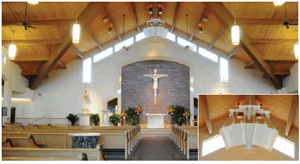New Lease Onlife

Church Of The Incarnation Gives Its New Sanctuary Great Sound
MANTUA, NJ—When the Church of the Incarnation held its first service in 1937, the tiny community of Mantua, NJ was home to a small group of farmers. By 2002, Mantua had grown to a thriving Philadelphia suburb, and a membership of nearly 3,000 congregants celebrated the opening of the church’s new 1,000-seat sanctuary.
The fan-shaped venue boasts exquisite architecture, with soaring peaked ceilings, stone tiled floors, and ornamental windows—but those lovely features presented a number of acoustical challenges. Inset: The new system utilizes a center cluster of four Community SLS920 three-way cabinets to cover the entire sanctuary, augmented by a single SBS22 subwoofer.
The fan-shaped venue boasts exquisite architecture, with soaring peaked ceilings, stone tiled floors, and ornamental windows. But those same features presented a number of acoustical challenges, and as JD Sound and Video’s Joe DiSabatino explained, the sanctuary’s original sound system left much to be desired. “As often happens in a new construction project, audio was a secondary concern,” he said. “The system was designed to fit a budget, rather than a building, and was long a source of frustration for them.”
Adding to the acoustical challenges was the sanctuary’s somewhat unique layout, placing the choir and organist at the rear of the hall. “Even after installing some small monitor speakers back there, the choir were never able to really hear themselves the way they wanted to,” DiSabatino said.
Using EASE, DiSabatino designed a new system utilizing a center cluster of four Community SLS920 three-way cabinets to cover the entire sanctuary, augmented by a single SBS22 subwoofer. Crown CTs Series amplification powers the rig, with a Rane RPM22z providing DSP. A Mackie 24.4 console is installed at FOH. A four-channel Shure UHF system utilizing Countryman E6i headset mics covers the ministry presenters, and a selection of Shure hard-wired mics is on hand for the musicians and performers.
The new system has more than addressed the sanctuary’s long-standing intelligibility issues, to the relief of both staff and congregants. “In a Catholic church, spoken word should be the highest priority in system design,” observed Francis West, the church’s audio director. “We’ve always had certain seating areas that were problematic, where the old system didn’t quite project as it should have and congregants had trouble making out the sermons. JD Sound and Video and Community really listened to our concerns and worked with us to create a new system that would address those issues. The new system has made a dramatic improvement; spoken word is clear and crisp to every seat.”
A daily selection of the top stories for AV integrators, resellers and consultants. Sign up below.
As formidable as the building’s acoustics were, the church’s busy schedule proved to be even more of a challenge. “Once we submitted the system design, we had less than a month to get the system installed and running in time for Palm Sunday mass,” DiSabatino said. Murphy’s Law being what it is, logistics then entered into the fray, making a compressed schedule even tighter. “When we got in there we discovered that much of the conduit we’d planned to use was either smaller than expected or non-existent, so we ended up spending three extra days cutting into drywall, removing baseboards, and fishing wires through some pretty tight spaces. We were literally walking out with our vacuum as the people were walking in for mass.”
In addition to daily mass and numerous Sunday services, the sanctuary also hosts a wide range of church and community events, from concerts featuring national and regional Christian artists to plays and performances sponsored by local schools and organizations. “Versatility was an important requirement for the system,” DiSabatino said. “We wanted to create a system that would deliver musicality with the same quality as it delivers intelligibility, and I believe we’ve successfully done that. We’ve achieved substantially more gain before feedback and several of the musicians have remarked that the instruments finally sound the way they’re supposed to.”
The AVNetwork staff are storytellers focused on the professional audiovisual and technology industry. Their mission is to keep readers up-to-date on the latest AV/IT industry and product news, emerging trends, and inspiring installations.
